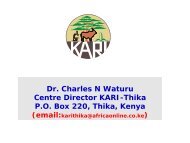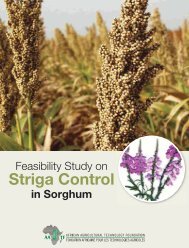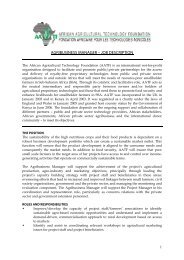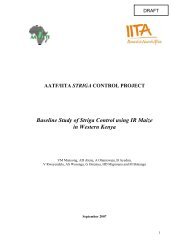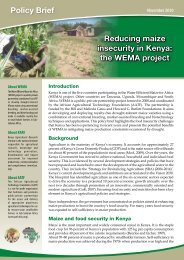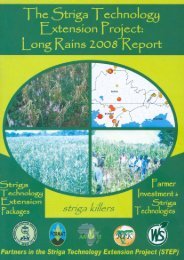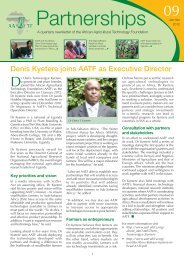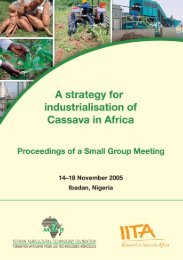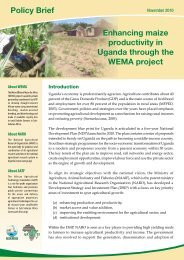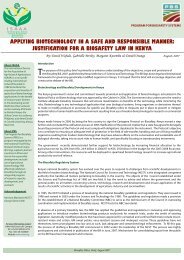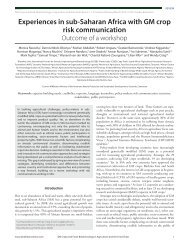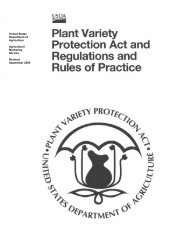AATF Inaugural Report - African Agricultural Technology Foundation
AATF Inaugural Report - African Agricultural Technology Foundation
AATF Inaugural Report - African Agricultural Technology Foundation
You also want an ePaper? Increase the reach of your titles
YUMPU automatically turns print PDFs into web optimized ePapers that Google loves.
A New Bridge to Sustainable <strong>Agricultural</strong> Development in Africa<br />
distribute them to smallholder farmers. These<br />
latter steps are absolutely critical to achieving<br />
meaningful impact at the farm level, and <strong>AATF</strong><br />
facilitates this work by entering into contracts<br />
with relevant organisations to make sure that the<br />
new products reach resource-poor farmers.<br />
<strong>AATF</strong>’s strategy rests on fundamental<br />
principles that were defined during the extensive<br />
stakeholder consultations leading up to the<br />
creation of the <strong>Foundation</strong>. These principles<br />
underpin all <strong>AATF</strong> activities and relationships:<br />
1) First, the <strong>Foundation</strong> strives to achieve its<br />
goals and objectives through the creation<br />
and facilitation of enduring public–private<br />
partnerships;<br />
2) It can whenever necessary serve as the<br />
“responsible party” in these novel partnerships,<br />
so as to ensure the interests both of<br />
technology providers and users are protected;<br />
3) It operates along the entire product value<br />
chain – a unique attribute of the organisation<br />
– facilitating project implementation and the<br />
delivery of products to farmers;<br />
4) <strong>AATF</strong> is willing to promote the transfer<br />
of all types of technologies, as long as the<br />
process is demand driven and the potential<br />
impacts on food security and poverty are<br />
clear;<br />
5) <strong>AATF</strong> facilitates the transfer of proprietary<br />
technologies according to <strong>African</strong> needs and<br />
priorities, working closely with public and<br />
private suppliers regardless of their location;<br />
6) The primary focus of the <strong>Foundation</strong> in its<br />
choice of projects is on food crops and on the<br />
needs of sub-Saharan Africa’s smallholder<br />
farmers; and<br />
7) <strong>AATF</strong> takes a practical, business-like<br />
approach to determining how technologies<br />
will be licensed and deployed.<br />
Incorporation and Location<br />
In order to expedite the work of the organisation,<br />
it needed to be incorporated within a robust and<br />
predictable legal environment with well established<br />
contract and intellectual property laws. It<br />
was decided that the United Kingdom provided<br />
the best fit between the needs of the <strong>Foundation</strong><br />
and those of its potential partners. In January<br />
2003, <strong>AATF</strong> was incorporated as a company<br />
limited by guarantee, and subsequently registered<br />
in the United Kingdom in January 2005 as a<br />
charity under the laws of England and Wales.<br />
Several countries were considered for the<br />
location of the <strong>Foundation</strong>’s headquarters, including<br />
Ghana, Kenya, Uganda and South Africa.<br />
All had positive attributes, but in the end it was<br />
decided that Kenya was the most appropriate<br />
choice. In April 2003, at the invitation of the<br />
Government of Kenya, <strong>AATF</strong> was registered<br />
as a foreign private limited company under the<br />
laws of Kenya. The <strong>Foundation</strong> operates from<br />
the International Livestock Research Institute’s<br />
(ILRI) Nairobi campus.<br />
Structure and Governance<br />
The <strong>Foundation</strong>’s structure and governance create<br />
a clear separation between responsibility for setting<br />
and monitoring strategy and the day-to-day<br />
management of operations (see Figure 2). <strong>AATF</strong>’s<br />
corporate design is intended to limit liability risks<br />
for the <strong>Foundation</strong>’s donors. It allows for wide<br />
stakeholder participation without constraining<br />
operational flexibility and, as an independent<br />
charitable private company, protects the organisation<br />
from undue external pressures.<br />
During the period covered by this <strong>Inaugural</strong><br />
<strong>Report</strong>, 11 distinguished individuals served on<br />
the <strong>AATF</strong> Board of Trustees. Board members<br />
possess a range of relevant skills and are drawn<br />
20



